Schneider P., Eberly D.H. Geometric Tools for Computer Graphics
Подождите немного. Документ загружается.

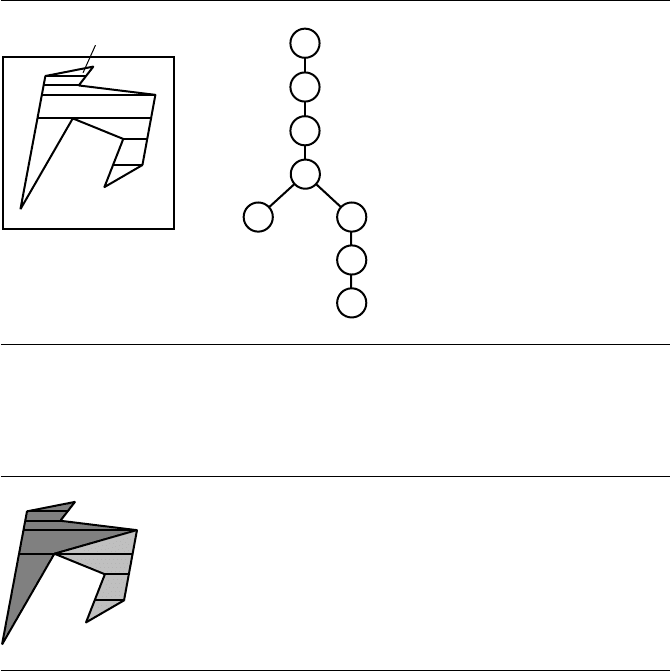
784 Chapter 13 Computational Geometry Topics
17
29
27
16
21
11
3
28
17
29
27
28
11 16
21
3
Figure 13.68 The sample polygon after trapezoids are merged into maximally sized ones.
Figure 13.69 The sample polygon as a union of monotone polygons. The two polygons are drawn
in light gray and dark gray. The horizontal line segments from the trapezoidal de-
composition are still shown.
on the trapezoid’s top edge. Similarly, a cusp that opens upward occurs on the top
edge of some trapezoid. A line segment is added from that cusp to the vertex on the
trapezoid’s bottom edge. It is possible that both end points of the newly added seg-
ment are cusps. Figure 13.69 shows the polygon of the ongoing example. Only one
line segment needed to be added, from a downward opening cusp to a vertex on the
trapezoid’s top edge. The polygon consists of two monotone polygons.
The last paragraph had the assumption that no two vertices have the same y-
value. This can, of course, happen in practice. The algorithm for adding line segments
to form monotone polygons must be slightly modified to handle this case.
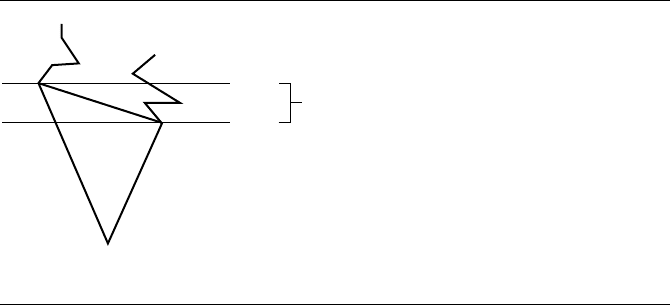
13.9 Polygon Partitioning 785
V
min
V
0
V
1
y
1
y
0
Polygon is monotonic in strip
using edge 具V
min
, V
0
典 or
edge 具V
1
, V
0
典
Figure 13.70 If the triangle at an extreme vertex is an ear, removing the ear yields another mono-
tone polygon.
Monotone Polygon Triangulation
The polygons obtained in the decomposition of a simple polygon are monotone with
respect to the y-axis. That is, any line in the x-direction intersects a y-monotone
polygon in one point (an extreme point in the y-direction), in two points (the typical
case), or along an entire edge of the polygon (edge is horizontal). The triangulation
of a monotone polygon requires only O(n) time to compute (Fournier and Mon-
tuno 1984). The method involves a greedy algorithm that removes triangles from the
extreme ends of the polygon.
First, let us just try to remove a triangle from an extreme end of the polygon
to see what issues arise. Let V
min
and V
max
be the extreme points of the polygon.
The polygon has two monotonic chains referred to as the left chain and the right
chain.LetV
0
= (x
0
, y
0
) be the vertex on the left chain that is adjacent to V
min
, and
let V
1
= (x
1
, y
1
) be the adjacent one on the right chain. For the sake of argument,
assume y
0
≥ y
1
. Otherwise, we can make the same argument with the roles of the
chains reversed. If the triangle V
0
, V
min
, V
1
is an ear, that ear can be removed and
added to the list of triangles in the triangulation. The edge V
min
, V
0
of the left chain
is removed and replaced by the edge V
1
, V
0
. The modified chain is still monotonic
in the y-direction, so the process can be repeated on the new monotone polygon at
its minimum vertex. Figure 13.70 provides an illustration.
The problem with this approach is that it requires determining whether or not the
triangle at the minimum vertex is an ear. In fact, the minimum vertex might not be
an ear tip. Figure 13.71 shows two types of failure that can occur. Failure to be an ear
tip can occur simply because the next edge on the right chain V
0
, W is inside the
triangle V
0
, V
min
, V
1
(Figure 13.71(a)). The failure might also be a result of more
complex behavior, for example, a chain of vertices in the strip y
1
<y<y
0
that are
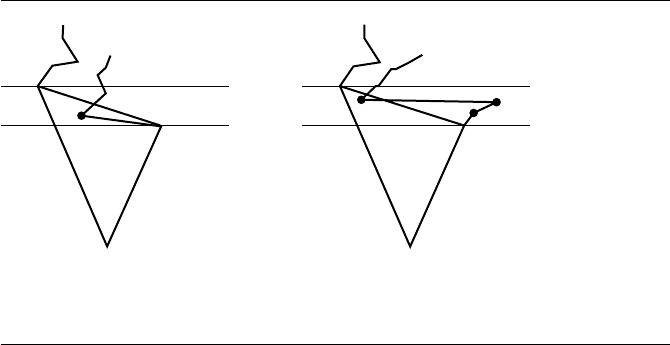
786 Chapter 13 Computational Geometry Topics
V
min
V
min
V
0
V
0
V
1
V
1
W
W
U
(a) (b)
Figure 13.71 Failure of triangle V
0
, V
min
, V
1
to be an ear.
outside the mentioned triangle, but the next vertex W in that chain being inside the
triangle (Figure 13.71(b)).
The configuration in Figure 13.71(a) is easy to handle. The triangle V
min
, V
1
, W
is an ear and can be removed. The edge V
min
, V
1
in the right chain is removed and
replaced by V
min
, W. The right chain is still monotonic, so the reduced polygon is
monotonic and the process can be repeated. The removal can occur even if W is not
inside V
0
, V
min
, V
1
as long as V
1
isaconvexvertex.
The configuration in Figure 13.71(b) is the more interesting one. A sequence of
reflex vertices occur, called a reflex chain. In the figure, the predecessor U to W is the
first vertex occurring after the reflex chain, so it is a convex vertex, and the very next
edge with end point W makes the reflex chain invisible from V
0
. All vertices in the
reflex chain, however, are visible to W , so all triangles formed by W and the vertices
in the reflex chain can be removed. The right chain reduces to a monotonic chain
whose first three vertices are V
min
, W , and U . The reduced polygon is still monotonic.
Even so, the configuration in Figure 13.71(b) is still not representative of other
configurations. The vertex W might not be in the triangle V
0
, V
min
, V
1
, yet the tri-
angles formed by it and the reflex chain vertices can be removed. Worse is that not all
of the reflex chain vertices are visible to W. Figure 13.72 illustrates this configuration.
After all the valid triangles are removed, W will be the next vertex to be added to the
reflex chain.
The final variation is that W might occur above the strip rather than inside it. In
this case, the vertices in the reflex chain are all visible to V
0
. It is sufficient to form
all triangles containing V
0
and the reflex vertices and remove them. Observe that in
this case, the triangle V
0
, V
min
, V
1
is an ear of the polygon, exactly the motivation
originally for attempting to remove that triangle first. The valid triangles are removed
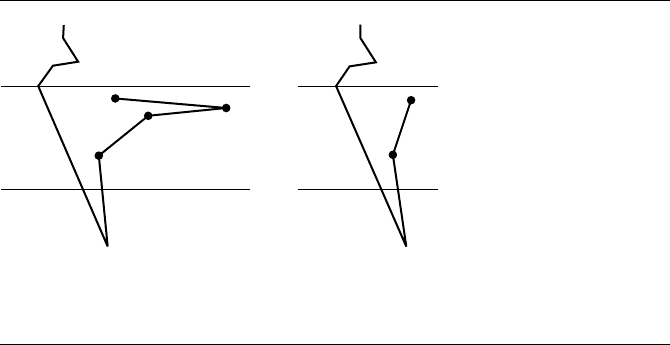
13.9 Polygon Partitioning 787
V
min
V
min
V
0
V
0
V
1
V
2
V
3
V
1
W
W
(a) (b)
Figure 13.72 (a) Not all reflex chain vertices are visible to W. (b) Removal of the triangles leads to
W being the next vertex to be added to the reflex chain.
starting with this one. Figure 13.73 illustrates this. The difference between the con-
figurations in Figures 13.72 and 13.73 is the y-ordering of V
0
and W . To handle this,
the vertices from both left and right chains must be sorted in a single list. Since the
left and right chains are already sorted, the full sort requires a merge of two sorted
lists, an operation that is performed in O(n) time.
The pseudocode for triangulating a y-monotone polygon is listed below. The
left and right chains are passed separately, each having the vertex with minimum
y-value in the slot zero and each having the vertex with maximum y-value in the
corresponding last slot.
void TriangulateMonotone(int NL, Point LChain[NL], int NR, Point RChain[NR],
TriangleList TList)
{
// Each node in the list contains a vertex and an identifier of the
// chain to which the vertex belongs.
VertexList VList = MergeChains(NL, LChain, NR, RChain);
// A list whose front corresponds to the y-minimum vertex and whose rear
// corresponds to the y-maximum vertex.
ReflexChain RList;
// Initialize the chain with the first two vertices. AddMax(VList) places
// the specified list node at the end of the chain. A side effect of the
// operation is to provide RList with a ’whichChain’ tag, L or R, about
788 Chapter 13 Computational Geometry Topics
// which of the left or right polygon chains the current reflex chain belongs.
RList.AddMax(VList); VList = VList.Next();
RList.AddMax(VList); VList = VList.Next();
// VList points to the third vertex in the list.
while (VList is not empty ) {
// Max() is an accessor to the rear of the reflex chain that contains
// the vertex of maximum y-value.
if (VList.Previous() is equal to RList.Max()) {
// VList.vertex is on the same chain as the reflex chain
if (RList.Max() is a convex vertex) {
TList.Add(RList.Max().Previous().vertex);
TList.Add(RList.Max().vertex);
TList.Add(VList.vertex);
// Remove vertex from reflex chain and from vertex list. These
// are the same vertex.
RList.RemoveMax();
VList.Previous().RemoveSelf();
if (RList is empty)
VList = VList.Next();
} else {
// RList.Max() is a reflex vertex, no collinear allowed
RList.AddMax(VList);
VList = VList.Next();
}
} else {
// VList.vertex is on the opposite chain to the reflex chain.
// Min() is an accessor to the front of the reflex chain that
// contains the vertex of minimum y-value.
TList.Add(RList.Min().vertex);
TList.Add(RList.Min().Next().vertex);
TList.Add(VList.vertex);
// Remove vertex from reflex chain and from vertex list. These
// are the same vertex.
RList.RemoveMin();
VList.Previous().RemoveSelf();
if (RList is empty)
VList = VList.Next();
}
}
}
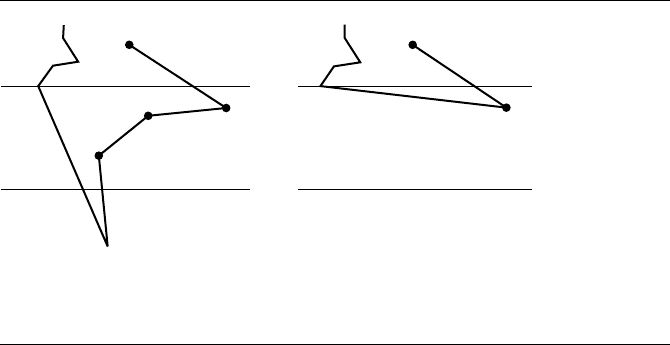
13.9 Polygon Partitioning 789
V
min
V
0
V
0
V
1
V
2
V
3
V
3
WW
(a) (b)
Figure 13.73 (a) W occurs above the current strip, V
0
is visible to all reflex chain vertices. (b) Re-
moval of the triangles leads to a reduced monotone polygon, so the process can be
repeated.
In summary, a simple polygon is triangulated by decomposing it into horizontal
strips of trapezoids, merging the trapezoids into maximal pieces, connecting vertices
between top and bottom trapezoid edges to form y-monotone polygons, then trian-
gulating the monotone polygons.
A variation on this algorithm presented in O’Rourke (1998) finds monotone
mountains. These are monotone polygons for which one of the monotone chains
is a single line segment. Triangulating a monotone mountain is easier than triangu-
lating a monotone polygon because it is easier to identify ears and remove them, one
at a time. An implementation looks similar to the ear clipping presented earlier in
this chapter.
13.9.4 Convex Partitioning
A polygon triangulation is a special case of partitioning the polygon into convex sub-
polygons, the number of subpolygons being n − 2 for n vertices. A more general
problem is to partition the polygon into convex subpolygons, but minimize the num-
ber of such subpolygons. Clearly a triangulation does not do this. A square has two
triangles in its triangulation, but is already convex, so the optimum number of con-
vex pieces is one. Convex partitioning is useful for allowing artists to construct 3D
polygonal models without concern for generating nonconvex faces. The models can
be postprocessed to partition the faces so that all faces are convex. Moreover, gener-
ating the minimum number of convex faces is useful for a renderer whose primitives
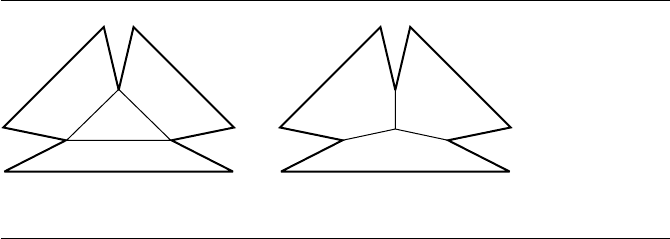
790 Chapter 13 Computational Geometry Topics
(a) (b)
Figure 13.74
(a) Partition using only vertices. (b) Partition using an additional point interior to
the polygon.
include convex polygons. By minimizing the number of input primitives, the setup
costs for rasterizing the polygons is minimized.
A triangulation always uses diagonals of the polygon as edges of the triangles.
Optimal convex partitioning might require additional points and segments to be
specified in order to obtain the minimum number of subpolygons (see Figure 13.74).
The convex partitioning methods mentioned in this section only use diagonals for
the construction.
Chazelle showed that the minimum number µ of convex subpolygons in a par-
tition is bounded by r/2+1 ≤ µ ≤ r + 1, where r is the number of reflex vertices
of the polygon. The bounds are tight since it is easy to construct two polygons, one
whose optimum partition attains the lower bound and one whose optimum partition
attains the upper bound. Algorithms that construct an optimum partition tend to run
slowly (in asymptotic terms). Algorithms that partition rapidly tend not to obtain the
optimum number of pieces. In this section we provide an example of each.
A Suboptimal But Fast Convex Partitioning
A fast and simple algorithm for producing a convex partitioning that is suboptimal is
presented by Hertel and Mehlhorn (1983). However, it is known that the number of
convex subpolygons is no larger than four times the optimal number. Given a convex
partition involving diagonals, a diagonal incident to a vertex V is said to be essential
for that vertex if removing the diagonal shared by two convex subpolygons leads to
a union that is not convex (at V ). Otherwise the diagonal is said to be inessential.A
diagonal connecting two convex vertices is clearly inessential. It must be that for a
diagonal to be essential for V , the vertex must be reflex. However, a reflex vertex can
be an end point for an inessential diagonal (see Figure 13.75).
The algorithm is simple. Start by triangulating the polygon. Remove each inessen-
tial diagonal, one at a time. The triangulation has O(n) diagonals, so the removal
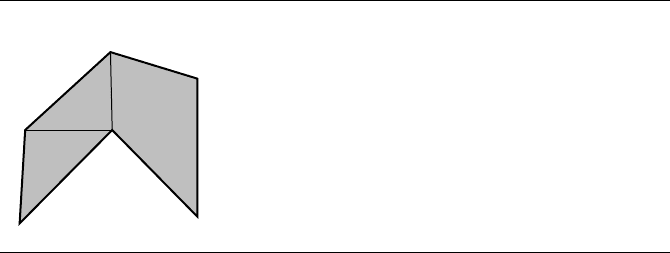
13.9 Polygon Partitioning 791
V
2
V
1
V
0
Figure 13.75 Ve r t ex V
0
is reflex. The diagonal V
0
, V
1
is inessential. The diagonal V
0
, V
2
is essen-
tial for V
0
.
phase is O(n). In theory the triangulation can be done in O(n) time, so this subop-
timal partitioning can be done in O(n) time. But as mentioned before, the triangu-
lation algorithms implemented in practice are asymptotically slower, so the time for
partitioning is dominated by the triangulation time.
An Optimal Convex Partitioning
An optimal partitioning algorithm by Keil and Snoeyink (1998) is described in
this section. The algorithm uses only diagonals and has an asymptotic run time of
O(nr
2
),wheren is the number of polygon vertices and r is the number of reflex
vertices. The algorithm is based on dynamic programming (Bellman 1987).
The simple polygon has counterclockwise-ordered vertices V
i
for 0 ≤ i<n.The
diagonals are denoted by d
ij
=V
i
, V
j
for i<j. The only diagonals that need to be
considered are those that have at least one end point that is a reflex vertex. A diagonal
with two convex vertex end points can clearly be removed to join two convex sub-
polygons into a single convex subpolygon. Thus, an optimal convex partitioning will
never have diagonals with both end points being convex vertices. It is not necessary
that a diagonal connecting two reflex vertices be part of the optimal partitioning.
Dynamic programming finds the optimal solution to a problem by combining
optimal solutions to subproblems of the same form as the original. Given a diagonal
d
ik
, the subproblem involves the subpolygon P
ik
whose vertices are V
i
, V
i+1
, ..., V
k
.
This polygon must itself be optimally partitioned into convex pieces. The size of this
problem is the number of vertices in the polygon. The original polygon is P
0,n−1
and
has size n. The subpolygon P
ik
has size k − i + 1. The weight w
ik
of the problem
is the minimum number of diagonals in a convex partitioning of P
ik
. The optimal
partitioning involves computing the weight w
0,n−1
of the original polygon P
0,n−1
.A
792 Chapter 13 Computational Geometry Topics
convention is made that the edge d
0,n−1
is considered to be a diagonal. The optimiza-
tion is done from the bottom up, so for initialization we need w
i,i+1
=−1 for all i.
As indicated in Keil (1985), P
ik
can have exponentially many decompositions that
attain weight w
ik
. However, by defining equivalence classes of decompositions, the de-
composition of P
ik
is simplified. Each decomposition of P
ik
has an associated pair of
vertex indices [a, b], with possibly a =b, the vertices with indices a, i, k, b occurring
in clockwise order in one of the convex polygons in the decomposition. Two decom-
positions are equivalent if they have the same weight and the same associated pair of
indices. Additionally, some minimum decompositions are labeled as narrowest pairs,
those whose convex regions in a small neighborhood of d
ik
do not contain the con-
vex region of any other minimum decomposition of P
ik
. Keil (1985) observed that
only narrowest pairs need to be considered when constructing solutions to the sub-
problem P
ik
. Figure 13.76 shows an original polygon (upper left) and 11 minimum
convex decompositions. The narrowest pairs are shaded in gray. As it turns out, the
angular order of diagonals d
ij
1
through d
ij
k
, counterclockwise about a vertex V
i
, is the
same as the order of the vertices V
j
1
through V
j
k
, counterclockwise about the poly-
gon. A consequence of this observation is that narrowest pairs for the subproblem
P
ik
can be tested for by just comparing indices of the associated pairs. Any associated
pair [a
0
, b
0
] of a potential decomposition is discarded whenever another associated
pair [a
1
, b
1
] with smaller indices is encountered; if a
1
≤ a
0
, it must also be the case
that b
1
≤ b
0
. As narrowest pairs for the subproblem for P
ik
are computed, they are
pushed onto a stack so that the pairs from the bottom to the top of the stack are in
counterclockwise order about vertices V
i
and V
k
. The stack for the polygon in Fig-
ure 13.76 will contain [1, 3], [3, 4], and [6, 8], the last pair being the top of the stack.
The diagonals d
06
and d
89
thereby form the narrowest pair that is furthest counter-
clockwise.
Another key idea involves canonical triangulations of the convex polygons in the
decomposition. Each triangulation of a convex polygon is a triangle fan where the
base vertex of the fan is a reflex vertex of that convex polygon. Figure 13.77 illustrates
the canonical triangulations. The polygon of the figure is from Keil and Snoeyink
(1998), but with the vertices labeled differently to meet the constraint in the paper
that V
0
is a reflex vertex. The reflex vertex used as the base vertex of a fan has the
smallest index of all reflex vertices in the convex polygon for which the fan is con-
structed. Keil and Snoeyink mention the following observations. In a canonical tri-
angulation of the original polygon P , each diagonal d
ik
with i<ksatisfies three
conditions with respect to subpolygon P
ik
:
1. The diagonals with end points in P
ik
define a canonical triangulation of P
ik
.
2. If V
i
is a reflex vertex of P , then for the triangle V
i
, V
j
, V
k
with i<j<k, either
j = k −1ord
jk
is a diagonal used in the convex decomposition.
3. If V
i
is not a reflex vertex of P , then V
k
is a reflex vertex. For the triangle
V
i
, V
j
, V
k
with i<j<k, either j =i +1ord
ij
is a diagonal used in the convex
decomposition.
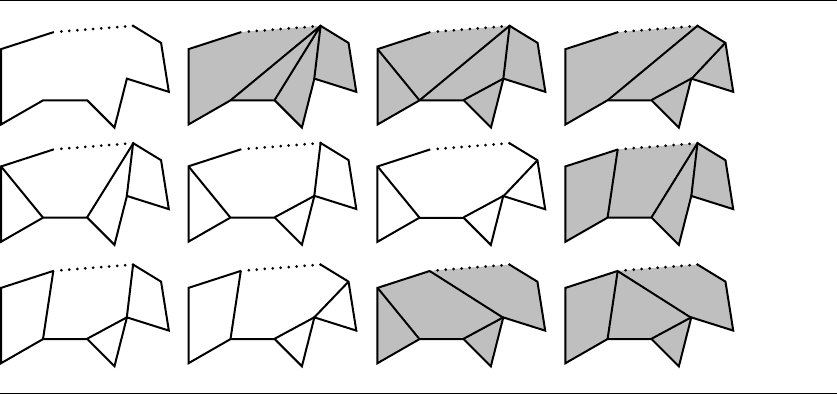
13.9 Polygon Partitioning 793
1
1, 3 1, 3 1, 3
3, 41, 81, 61, 4
3, 6 3, 8
6, 8 6, 8
0
9
8
7
6
2
34
5
Figure 13.76 Original polygon (upper left) and 11 minimum convex decompositions, with the nar-
rowest pairs shaded in gray. A dotted line indicates that the edge of the polygon is treated
instead as a diagonal.
In Figure 13.77, consider subpolygon P
9,11
so that i = 9 and k =11. The vertex
V
9
is reflex, so condition 2 applies. Triangle V
9
, V
10
, V
11
is in the canonical trian-
gulation of P and has j = 10 = k −1. In subpolygon P
16,23
, i = 16 and k = 23. The
vertex V
16
is reflex, so condition 2 applies. Triangle V
16
, V
17
, V
23
is in the canonical
triangulation of P , but j =17 =22 =k −1. However, d
17,23
is a diagonal used in the
convex decomposition. Consider subpolygon P
5,9
,soi = 5 and k =9. The vertex V
5
is not a reflex vertex, but V
9
is. Triangle V
5
, V
6
, V
9
is in the canonical triangulation
of P and has j = 6 = i + 1.
The minimum convex decompositions of P
ik
are constructed by considering
which vertices V
j
form a canonical triangle with diagonal d
ik
and whether diago-
nals d
ij
and d
jk
either are part of the decompositions of P
ij
and P
jk
or are just part
of the canonical triangulation. Putting this all together, the algorithm is to exam-
ine the canonical triangulations of the minimum decompositions of P
ik
that have
narrowest pairs. The algorithm associates with each subpolygon P
ik
a stack S
ik
that
stores the narrowest pairs for P
ik
in increasing order and a stack T
ij
that stores these
pairs in decreasing order. An invariant of the algorithm is that when analyzing P
ik
,
each subproblem P
xy
smaller than P
ij
has all its narrowest pairs stored in its corre-
sponding stacks. Only one of the two stacks for a subproblem is used at a time, so
both can be overlaid in the same memory. The data structure to use for S
ik
is there-
fore a “double-ended stack.” Operations on S
ik
are applied at one end of the storage,
whereas operations on T
ik
are applied at the other end.
